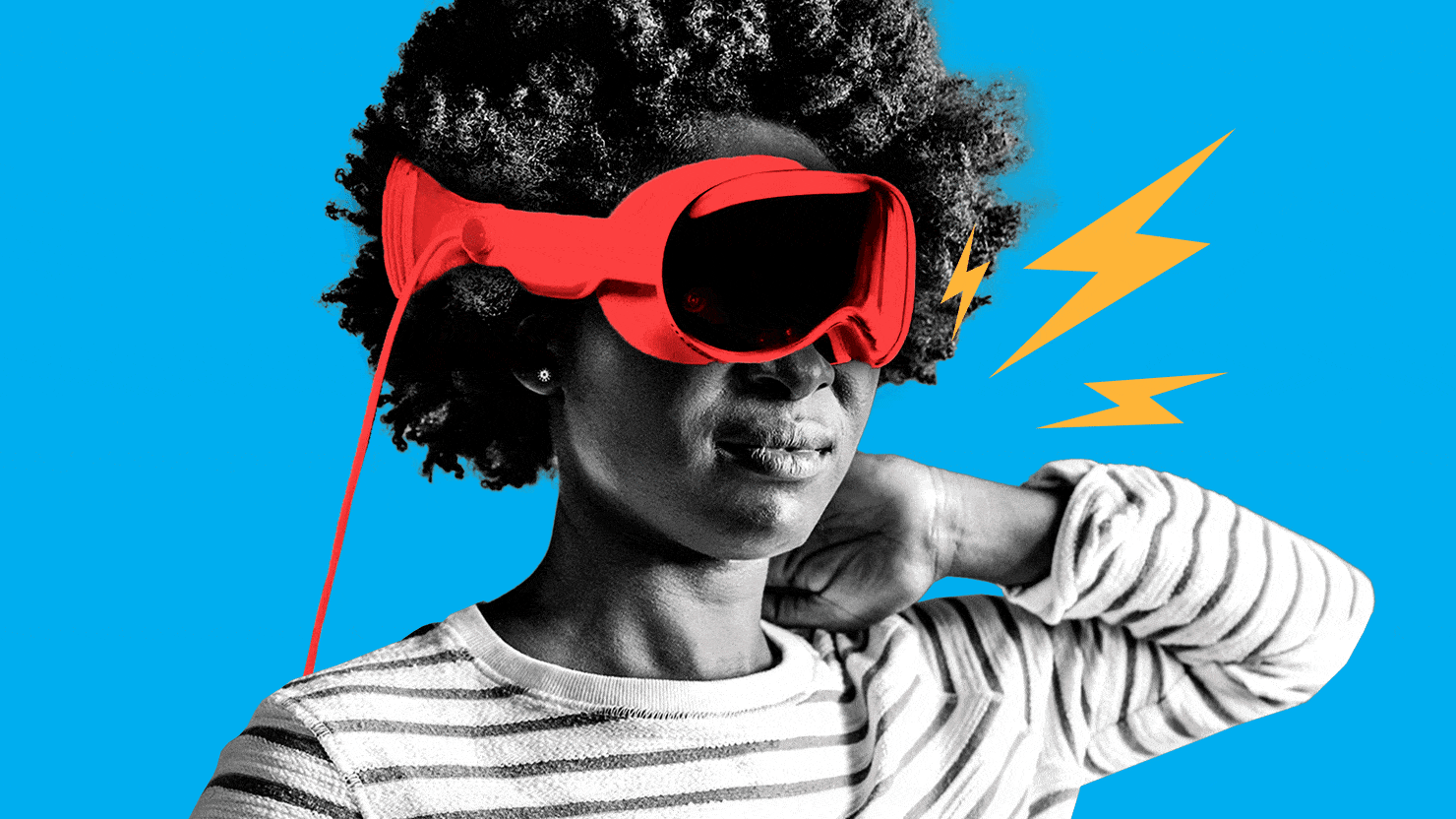The Apple Vision Pro is set to be released on Feb. 2—but the company is already allowing select folks in the media to test out the mixed-reality headset in the weeks ahead of launch.
While it’s garnered praise for its intuitive and accurate vision tracking—allowing you to highlight buttons and menus by just looking at it—and immersive, high-definition display, the Vision Pro is also getting one notable critique: It’s a downright pain in the neck.
“Damn this thing is heavy,” consumer tech YouTuber Marques Brownlee wrote in a post on X. “Also the typing experience is decent. There’s some new cool apps to check out. But wow. So heavy.”
“By the end of my demo, I started to feel the weight of the headset bring me back to the real world,” Victoria Song, a senior reporter for The Verge, wrote in her review of the headset. “I’d been furrowing my brow, concentrating so hard, I felt the beginnings of a mild headache.”
“It was wide, ridged, and soft, and I at first thought it would be very comfortable,” Engadget’s Cherlynn Low wrote in her review, referring to the device’s head strap. “But 15 minutes into my experience, I started to feel weighed down by the device, and five more minutes later, I was in pain.”
The pain is on Apple’s radar as well: In early tests, the company found that the Vision Pro “caused neck strain in testing due to its size and weight,” Bloomberg reported. “That could turn off consumers already wary of mixed-reality headsets, which meld virtual and augmented reality.”
(Apple is also already looking into releasing a smaller, lighter version of the device that, presumably, won’t require physical therapy to use.)
The issue is so bad that it’s even spawned an entirely new meme surrounding its weight issues, with many users on social media taking the opportunity to absolutely dunk on the VR headset for the neck pain it’s been causing early users.
“It’s not surprising that prolonged use of any headset can lead to neck pain or muscle fatigue,” Michael Lee, orthopedic spine surgeon at the University of Chicago Medical Center, told The Daily Beast. “The head itself weighs about 10 to 11 lbs. These devices usually weigh close to 1 to 1.5 lbs, so it is an additional 10 percent of weight that one’s neck muscles have to accommodate.
When compared to other popular VR headsets, the Vision Pro is indeed a bit heavier than its peers. The device weighs 21.2 to 22.9 ounces depending on the headband and add-ons that users can attach. That’s more than the Meta Quest 2 (17.7 ounces), Meta Quest 3 (18.2 ounces) and the Sony Playstation VR2 (19.7 ounces), according to Apple World Today. However, that’s still lighter than the HTC Vive Pro (29.92 ounces) and the Meta Quest Pro (25.5 ounces).
Weight isn’t everything though. Ergonomics play just as important a factor in how comfortable a device like the Apple Vision Pro will ultimately be. That’s why Apple also recently announced that it would be shipping a dual loop headband that includes a top strap along with the device to users. The dual loop band distributes the weight of the device across the head and neck to reduce strain.
Of course, this can be a significant hurdle for both Apple’s ambitions for the Vision Pro and the future of VR/AR headsets as a whole. While many companies including Mark Zuckerberg’s Meta have poured billions into the technology, it’s been clear that most consumers are hesitant to adopt the devices in their everyday lives.
Since Apple is positioning the Vision Pro to essentially be a replacement for your computer, smartphone, video game console, and television, neck pain and soreness might throw a big wrench in getting customers to purchase and wear it for—presumably—many hours of the day.
(With an eye-popping price tag of $3,499, customers might also be frustrated that their ludicrously expensive gadget is a big pain in the neck as well.)
“Our spines are designed to carry a certain amount of load while we maintain correct posture,”
Kern Singh, professor of orthopedic surgery at Rush University Medical Center and endoscopic spine surgeon, told The Daily Beast. When we increase the weight, then, it can affect our posture and impact the muscles in our necks. “It’s very plausible the headsets are causing neck pain even after just 15 minutes due to the extra weight.”
Research has shown that prolonged use of “helmets and headsets” are linked to neck pain, according to Singh. A study published in the journal Work in Sept. 2023 found that “higher weights were associated with shorter comfortable wear times” and that “not everyone could wear even the lightest headset (500 g) for the full two hours.”
However, the issue isn’t quite that dire. Lee recommends that users new to VR “condition their neck via exercises and/or physical therapy” to essentially train their necks to get used to the new weight. “In addition, I would recommend that they increase their usage of these devices in a gradual controlled fashion rather than starting off at several hours a day,” he added.
Similarly, Singh said that users need to just be mindful of their body when using the device. In fact, he said that VR headsets might actually hold a lot of potential for treating neck pain.
“Several studies have found that using VR headsets can help strengthen the muscles in your neck, leading to better posture and less neck pain,” Singh said. “Another study suggests that VR-based training can reduce headaches by improving the connections between our vision, neck muscle control, and the vestibular system, which helps us balance.”
While the device might be a pain in the neck at first, Singh said that it’s just a matter of being “extra conscious” of maintaining good posture while wearing the headset and making sure you take frequent breaks.
“If you’re starting to feel pain from the device, use that as a signal to stop,” he explained. “If you’re able to use the extra straps, it may help to distribute some of the weight of the device and decrease the risk of placing excessive force in one direction and straining the ligaments/muscles that cause neck pain.”
For now, the extra weight and potential for neck soreness doesn’t seem to be slowing down the immense amount of hype behind the Apple Vision Pro. The company has already sold out its initial batch of devices, with no units available for pick up in Apple Stores.
However, some industry analysts already suspect that the market may be losing interest in the device. If the Vision Pro gains a reputation for causing pain and soreness too, the gadget might just be a massive albatross around Apple’s neck.

Maria Malik is your guide to the immersive world of Virtual Reality (VR). With a passion for VR technology, she explores the latest VR headsets, applications, and experiences, providing readers with in-depth reviews, industry insights, and a glimpse into the future of virtual experiences.


